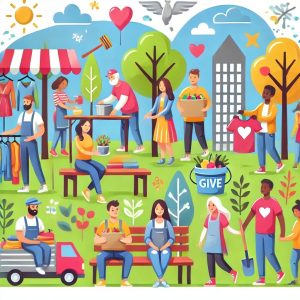In a world often focused on individual success and personal gain, the idea of giving back to the community can sometimes feel like a distant or even impossible goal. However, when individuals, families, and organizations take the time to contribute to their communities, the effects can be transformative—both for those receiving help and for the givers themselves. Giving doesn’t always require large donations or dramatic efforts; sometimes, the smallest acts of kindness can make the biggest difference. From volunteering time to donating skills or simply showing up when someone needs support, giving back is a powerful tool for building stronger, more connected communities.
One of the most impactful ways to give back is through volunteering. Whether it’s helping out at a local food bank, participating in neighborhood cleanups, or tutoring students after school, donating time and energy to causes in need strengthens the fabric of a community. Volunteering doesn’t just help those who benefit directly from the service—it also enriches the volunteers themselves. By getting involved, individuals can develop new skills, expand their networks, and gain a deeper sense of purpose. The act of giving, particularly when done selflessly, brings a sense of fulfillment that cannot be replicated by material possessions.
Another meaningful way to give back is through sharing one’s talents or expertise. Whether someone is an artist, a teacher, a lawyer, or a chef, offering skills to those in need can be life-changing. A community might be in need of an educational workshop, a legal aid clinic, or a fundraiser that requires professional event planning. By donating these specific skills, individuals not only make a tangible impact but also inspire others to contribute in similar ways. This kind of giving helps elevate the entire community, allowing people to thrive in ways they might not have been able to otherwise.
Giving back also fosters a culture of kindness and connection. In many communities, people may not always know how to ask for help, or they might feel hesitant to do so. By creating an environment where generosity is the norm—whether it’s through setting up mutual aid groups, creating food pantries, or organizing support networks—communities can create safety nets that uplift everyone. This sense of collective responsibility strengthens bonds between neighbors and helps ensure that no one is left behind.
In addition to community projects, supporting local businesses is another important way to give back. In times of economic hardship or uncertainty, spending money at small, local shops, cafes, and service providers helps stimulate the local economy and supports the livelihoods of entrepreneurs and their families. By supporting local businesses, individuals contribute directly to the health and prosperity of their community, helping it grow in a sustainable way.
Giving also encourages empathy and understanding. When people take the time to listen to each other, share their stories, and offer support, it creates an atmosphere of compassion. It opens up opportunities for people to connect across differences, whether those differences are cultural, economic, or ideological. By embracing a mindset of giving, communities can become more inclusive and supportive, fostering environments where everyone feels valued.
In the end, giving back is not just about making a difference in someone else’s life—it’s about making the world a better place for everyone. When we give more than we take, we create ripples of kindness that spread far beyond our immediate circles, transforming not only individual lives but entire communities. Whether through small gestures or large initiatives, each act of giving strengthens the community, nurtures connections, and builds a better, more compassionate world for the future.

